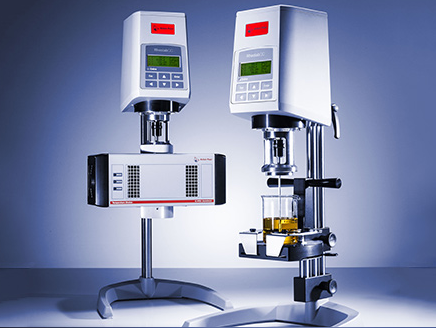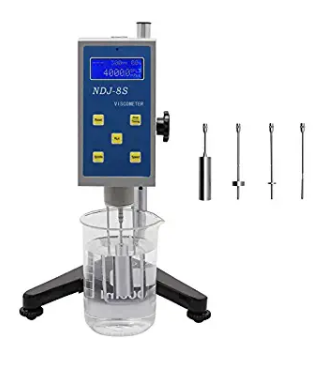What Is A Rheometer?
A Rheometer is a laboratory instrument used to measure the way in which a liquid, suspension or slurry flows in response to applied forces. It is used for those fluids which cannot be defined by a single value of viscosity and therefore require more parameters to be set and measured.
Types Of Rheometers
- Capillary Rheometer
- Extensional Rheometer
- Torque Rheometer
- Interface Rheometer
Rheometers have wide and varied applications in the material science and chemical industries for material such as oil, asphalt, Plastics, wax, paints, coatings and adhesives. They are also used for food and beverages and personal-care products such as cosmetics, shampoo and toothpaste.

What You Need To Know About Rheometer
- Rheometers are equipments used to determine the rheological properties of polymer melts, polymer solutions, suspensions, emulsions, coatings, inks and foods.
- Types of Rheometers include rotary Rheometer, capillary Rheometer, extensional Rheometer, torque Rheometer and interface Rheometer.
- Rheometer can measure rheological properties, fluid’s internal flow resistance and flow properties of liquids.
- Rheometer is used for those fluids which cannot be defined by a single value of viscosity and therefore require more parameters to be set and measured.
- Rheometer measures viscosity over a wide shear rate range.
- A Rheometer can work as a viscometer.
- A Rheometer can measure the properties of fluids under any condition, i.e whether a fluid follows or do not follow the Newton’s law of viscosity. Fluids that follow the Newton’s law of viscosity are referred to as Newtonian Fluids whereas those that do not follow are referred to as Non-Newtonian fluids.
- Rheometers are used in industries to monitor batch consistency and quality control.
What Is A Viscometer?
A viscometer is an instrument used to measure fluid viscosity and flow properties of liquids. Viscosity is the measure of a fluid’s resistance to flow (shear stress) at a given temperature. Viscometers only measure under one flow condition. Either the fluid remains stationary and an object moves through it or the object is stationary and the fluid moves past it. The drag caused by relative motion of the fluid and surface is a measure of the viscosity. The flow condition must have a sufficiently small value of Reynolds number for there to be laminar flow.

Types Of Viscometers
- Rotational viscometer
- Vibrational viscometer
- Oscillation viscometer
- Falling piston viscometer
- falling sphere viscometer
- Saybolt viscometer
- capillary tube viscometer
- orifice type viscometer
- Redwood viscometer etc.
Application Of Viscometers
- Measuring the flow of engine oil under different temperature conditions.
- Analyzing the flow properties of milk to design suitable piping systems.
- Checking the viscosity of jams and syrups to ensure batch consistency.
What You Need To Know About Viscometer
- A viscometer is an instrument used to measure fluid viscosity and the flow properties of liquids.
- There are several different types of viscometers; they include rotational viscometer, vibrational viscometer, oscillation viscometer, falling piston viscometer, falling sphere viscometer, Saybolt viscometer, capillary tube viscometer, orifice type viscometer, Redwood viscometer etc.
- Viscometer only measures viscosity of liquids.
- Viscometer is used to measure those fluids which can be defined by a single value of viscosity.
- Viscometer measures viscosity over a limited shear rate range.
- Viscometer cannot work as a Rheometer.
- Viscometers can only measure the viscosity of the fluid under certain conditions i.e a fluid that follows Newton’s law of viscosity.
- Viscometers are used in industries to monitor batch consistency and quality control.
Also Read: Difference Between Colorimeter And Spectrophotometer
Difference Between Rheometer And Viscometer In Tabular Form
| BASIS OF COMPARISON | RHEOMETER | VISCOMETER |
| Description | Rheometers are equipments used to determine the rheological properties of polymer melts, polymer solutions, suspensions, emulsions, coatings, inks and foods. | A viscometer is an instrument used to measure fluid viscosity and the flow properties of liquids. |
| Types | Capillary Rheometer Extensional Rheometer Torque Rheometer Interface Rheometer. | Rotational viscometer Vibrational viscometer Oscillation viscometer Falling piston viscometer Falling sphere viscometer, Saybolt viscometer Capillary tube viscometer Orifice type viscometer Redwood viscometer etc. |
| Function | It can measure rheological properties, fluid’s internal flow resistance and flow properties of liquids. | It only measures viscosity of liquids. |
| Functionality | It is used for those fluids which cannot be defined by a single value of viscosity and therefore require more parameters to be set and measured. | It is used to measure those fluids which can be defined by a single value of viscosity. |
| Shear Rate Range | It measures viscosity over a wide shear rate range. | It measures viscosity over a limited shear rate range. |
| Capability | It can work as a viscometer. | It cannot work as a Rheometer. |
| Condition For measurement | It can measure the properties of fluids under any condition, i.e whether a fluid follows or do not follow the Newton’s law of viscosity. | It can only measure the viscosity of the fluid under certain conditions i.e a fluid that follows Newton’s law of viscosity. |
| Application | They are used in industries to monitor batch consistency and quality control. | They are used in industries to monitor batch consistency and quality control. |
Comments are closed.